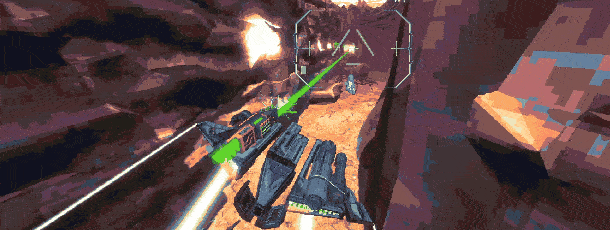There will be more data and proper atribution here (original author, steam link, original post date, etc) real soon, I promise. This is just like a technical test to see if they're coming in ok at all.
VergeWorld » From Amiga demoscene to your PC – the retro roots of VergeWorld
We’d like to share with you a bit more about the very retro beginnings of VergeWorld.
The idea for the game sparked back in 2018 at the head of Amiga demoscene enthusiast, Arek Kwaśny. He wanted to fulfill the childhood dream of creating an Amiga game, a retro sci-fi project inspired by the likes of Rescue on Fractalus and After Burner.
The first step was creating a brief adventure game prototype using modern software. Unity seemed to be a natural pick as it was supposed to revolve around rendering 360° panoramas in real-time. It provided relative freedom of movement in the 3D world. The second step was creating a voxel game prototype. It lacked the ability to turn in order not to overwork the Amiga 500 system.

Left: poster designed by Gary Winnick, one of the creators of Maniac Mansion
Right: artworks made for the Amiga prototype
Then it was time to code the game for the actual Amiga hardware. The first successful version of the demo was made during the AmiParty 2019. It was the first voxel code that ran on Amiga 1200. Even though it ran at 4-5 FPS, it was still a milestone that ignited the whole coding process between September and October 2019. After that, the demo was presented to the team at Bad Bones. The early version of the game’s engine resembled randomly appearing green blocks on the screen. Taking this into account, the progress that happened since then is colossal!

And so the works on VergeWorld: Icarus began with a goal to create a game that the Amiga world hasn’t seen yet. When it comes to the inspiration for the setting, at the beginning it was supposed to be a space opera telling a story of a smuggler flying in his spaceship through a canyon-filled planet. When you say space opera you think Star Wars, when you say space smuggler, you think about Han Solo.

But trying to fill in those shoes would be too much of a gamble, there would be too many similarities. Instead, we toned down a bit and turned to classics and modern titles. Specifically The Mandalorian, Dune, and The Outer Worlds to name a few. This way the team has created a sort of duality – on one hand, the player experiences a lot of familiar elements that they can easily identify with, and on the other, they have a fresh look at the retro sci-fi.
This was also the time when the team was forming – a mix of both demoscene veterans, pixel art maniacs, and those who didn’t really remember the 90s that well – all in order to combine both old and modern approaches.

After months of work, VergeWorld: Icarus became a retro sci-fi shoot’em up racer, where the players pick up the mantle of a mysterious pilot of the Icarus spaceship. The players try to gain the support of the faction of their choice, learn about the pilot, shoot quite a lot, and fly through endless canyons. The world presented in the game is a post-apocalyptic desert planet on which physics doesn’t work according to the rules we know. Under these circumstances, the most prominent human colonization mission is trying to survive in a place that by necessity has become their new home.
By the end of 2020, we were able to launch a second demo, this time for the Sega Genesis console.
By that time we’ve pushed both hardware to their limits. We also felt we could do more and appeal to a wider crowd. That’s why we started working on bringing VergeWorld to PC. This meant pausing the work on the hardware-limited retro version and switching back to the Unity engine equipped with everything we’d need. The team has grown even further, to over a dozen people.
We knew that the pixel art was staying, but the entire gameplay and graphical style had to undergo a redesign. On the audio and video layer, we decided to take our cues from the late 90s, the time when the first PlayStation entered the market and revolutionized 3D rendering in games.

As for the gameplay, we jumped onto the increasingly popular roguelite trend. Thus, we managed to combine retro design, which provides a fresher look than the widely used 2D pixel art, and modern game mechanics. In creating this version, inspiration from classic retro games was mixed with productions such as Hades, Returnal, Everspace, and Star Wars Episode I: Racer. Under the influence of new team members creating this “transformation”, the VergeWorld took on a whole new dimension that you’ll soon be able to experience yourself!
If you want to check the VergeWorld prototypes, you can download them for free. Also, be sure to check the PC demo version here on Steam and wishlist if you like it.

